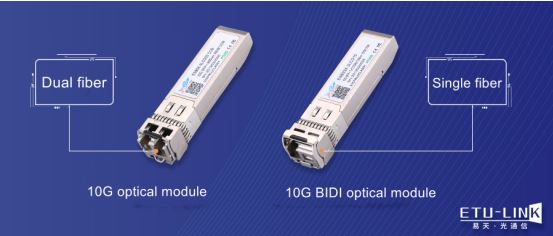
What is the difference between BIDI single-fiber bidirectional and dual-fiber bidirectional optical modules?
We believe that many small partners have a question in their minds, what are the differences between single-fiber and dual-fiber optical modules and their differences in application scenarios.In this article, ETU-LINK will explain the difference between BIDI single-fiber bidirectional and dual-fiber bidirectional optical modules.
First of all, there is an obvious difference in the interface type. The BIDI single-fiber bidirectional optical module uses a simplex SC or LC interface.while the dual-fiber bidirectional optical module uses a duplex LC interface, one is an optical transmitting interface, and the other is an optical receiving interface.

From the literal meaning, single-fiber bidirectional means that a single fiber can transmit and receive optical signals in two directions at the same time, just like a two-way single-lane, vehicles in both directions are driving in the same lane. The dual-fiber bidirectional is like a two-way two-lane. In one optical fiber, only signals in the same direction are transmitted.
The BIDI optical module has only one interface, divided into LC and SC. It is filtered by the filter in the optical module, and the 1310nm optical signal is transmitted and the 1550nm optical signal is received at the same time, or vice versa. Therefore, the module must be used in pairs, and its biggest advantage is to save fiber resources. However, the price of single-fiber BIDI optical modules will be more expensive than that of dual-fiber optical modules. Since only one optical fiber is required for transmission, the actual application cost will be higher than that of using dual-fiber when the transmission link is long enough. The optical transceiver is lower.
In addition, the optical components used in the dual-fiber optical module and the BIDI single-fiber optical module are also different. The optical transceiver components of the dual-fiber optical module are composed of TOSA and ROSA, while the BIDI single-fiber optical module is composed of BOSA.Among them, TOSA (optical transmitting assembly) includes TO-CAN laser, adapter, die sleeve, isolator, adjustment ring, ROSA (optical receiving assembly) includes detector and adapter, and BOSA is a combination of laser and detection Combined with the device, BOSA has more filters and bases than TOSA and ROSA components.
ETU-LINK single-fiber bidirectional optical module is usually used in user access network to complete image, data, voice and other communication at low cost.The dual-fiber bidirectional optical module is widely used, and can be used in application scenarios such as data centers, base stations, and enterprise networks.
Categories
New Blog
Tags
© Copyright: 2026 ETU-Link Technology CO ., LTD All Rights Reserved.

IPv6 network supported
Friendly Links:
易天官网